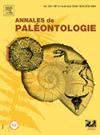New pipimorphs from the Late Cretaceous of Niger
IF 0.7
4区 地球科学
Q4 PALEONTOLOGY
引用次数: 0
Abstract
In Becetèn, in southeast Niger, is one of the few mid-Upper Cretaceous (Coniacian-Santonian) fossiliferous localities in Africa where multiple anuran taxa are known. Two of them, Pachycentrata taqueti and Inbecetenanura ragei, have been described from In Becetèn. Both are pipids, a clade composed of exclusively aquatic anurans. Beside these two pipids, numerous isolated bones have also been referred to anurans within the site, but never referred to any known less inclusive taxa. Here we describe several identified cranial and postcranial bones referable to Pipidae or its stem-group, which together constitute Pipimorpha. Among these elements, three cranial elements are referred to two unnamed pipimorphs. One of these has gondwanomorph affinities (pipids + South American and African extinct pipimorphs). These conclusions are supported by our phylogenetic analyses. Numerous postcranial elements are not referable to any of the four pipimorph taxa identified at In Becetèn, although some ilia might be tentatively referred to ?Pachycentrata sp. The presence of at least four distinct anuran taxa makes In Becetèn the most diverse anuran site in Mesozoic Africa. It is also the first site in the Mesozoic where four pipimorph taxa are identified. The dominance of pipimorphs in the anuran diversity of the site suggests that In Becetèn was likely more lacustrine than previously thought.
尼日尔晚白垩纪的新皮皮怪
在尼日尔东南部的becet,是非洲为数不多的中上白垩纪(coniian - santonian)化石地区之一,那里已知多个阿努拉类群。其中的两种,Pachycentrata taqueti和Inbecetenanura ragei,已经在《In becet》中被描述过。两者都是脂类动物,这是一个完全由水生无尾目动物组成的分支。除了这两种脂类外,还有许多孤立的骨头也被认为是该遗址内的无尾目动物,但从未涉及任何已知的包容性较低的分类群。在这里,我们描述了几个已确定的颅骨和颅后骨,可参考Pipidae或其茎群,它们共同构成pipiorpha。在这些元素中,三个颅元素涉及两个未命名的皮皮。其中之一具有冈氏形态的亲缘关系(皮脂类+南美和非洲灭绝的皮脂类)。这些结论得到了系统发育分析的支持。在In becet发现的四种pipimorph类群中,有许多颅后元素与其中任何一种都不相关,尽管一些ilia可能被暂定为Pachycentrata sp.。至少四种不同的无尾猿类群的存在使In becet成为非洲中生代最多样化的无尾猿遗址。这也是在中生代首次发现四种pipimorph分类群。pipiorphs在该遗址的无性动物多样性中的优势表明,in becet可能比以前认为的更像湖泊。
本文章由计算机程序翻译,如有差异,请以英文原文为准。
求助全文
约1分钟内获得全文
求助全文
来源期刊

Annales de Paleontologie
地学-古生物学
CiteScore
1.70
自引率
10.00%
发文量
8
审稿时长
>12 weeks
期刊介绍:
Créées par Marcellin Boule en 1905, les Annales de Paléontologie publient 4 numéros par an traitant des fossiles animaux et végétaux, dans tous les domaines de la paléontologie incluant :
-La Paléoanatomie-
La Paléohistologie-
La Morphologie fonctionnelle-
La Systématique-
L''Évolution-
La Paléoécologie
... et toute les contributions susceptibles d''améliorer la compréhension des organismes et des environnements éteints.
 求助内容:
求助内容: 应助结果提醒方式:
应助结果提醒方式:


